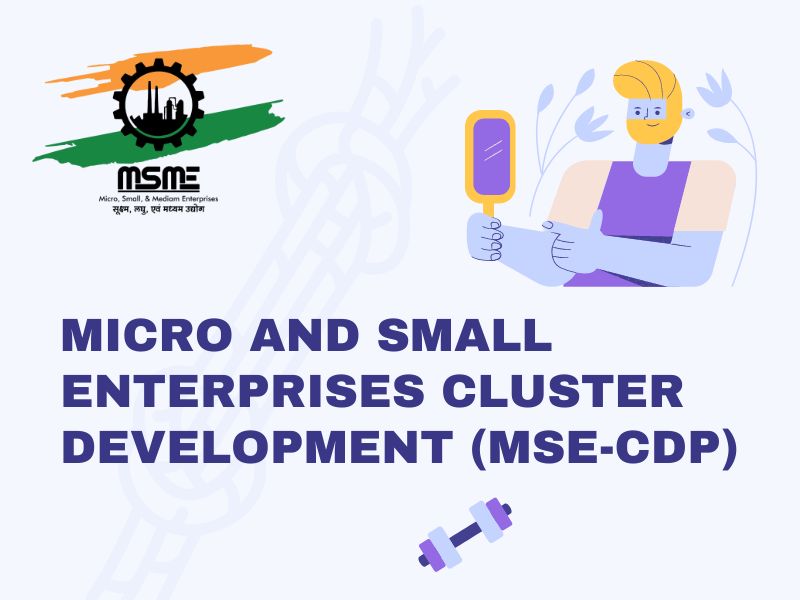In today’s competitive business landscape, micro and small enterprises (MSEs) play a pivotal role in driving economic growth, fostering innovation, and generating employment opportunities. Recognizing their significance, governments around the world have been implementing various policies and initiatives to support the growth of these enterprises. One such initiative is the Micro & Small Enterprises Cluster Development (MSE-CDP) Scheme, a strategic program aimed at promoting the development of clusters among micro and small enterprises. In this comprehensive article, we delve into the intricacies of the MSE-CDP Scheme, understanding its objectives, benefits, and the related schemes that amplify its impact.
Understanding the MSE-CDP Scheme
The MSE-CDP Scheme, launched by the government, is designed to enhance the competitiveness of micro and small enterprises by encouraging them to form clusters. Clusters are geographic concentrations of interconnected businesses, suppliers, service providers, and institutions related to a particular industry. The scheme aims to facilitate collaboration, knowledge sharing, and resource optimization among these enterprises, ultimately leading to improved overall performance.
Key Objectives
The primary objectives of the MSE-CDP Scheme are:
1. Promoting Innovation
By bringing together enterprises from similar or complementary sectors, the scheme stimulates innovation through the exchange of ideas, technologies, and best practices. This collective learning environment often results in the development of new products, processes, and services.
2. Enhancing Productivity
Clusters allow enterprises to pool resources and invest in common infrastructure, such as research and testing facilities. This shared access to advanced technologies and facilities leads to increased productivity and quality improvement.
3. Access to Markets
Participating in a cluster provides micro and small enterprises with better access to markets. Clusters enable joint marketing efforts, bulk purchasing, and increased bargaining power, which are particularly advantageous for enterprises with limited individual market reach.
Benefits for Participating Enterprises
Enrolling in the MSE-CDP Scheme can yield a range of benefits for micro and small enterprises:
1. Knowledge Exchange
Clusters foster an environment where enterprises can learn from each other’s successes and failures. This knowledge exchange helps in avoiding common pitfalls and adopting effective strategies for growth.
2. Cost Reduction
Pooling resources for common needs, such as infrastructure, bulk purchases, and marketing campaigns, results in significant cost savings for individual enterprises.
3. Skill Enhancement
Collaboration within clusters often involves training programs, workshops, and skill development initiatives. These opportunities contribute to upskilling the workforce and improving overall industry standards.
Impact on Local Economies
The MSE-CDP Scheme has a profound impact on local economies:
1. Employment Generation
As enterprises within clusters grow and expand, they create more employment opportunities, reducing unemployment rates and improving livelihoods in the region.
2. Regional Development
Clusters can become hubs of economic activity, attracting investments and fostering infrastructural development in previously underserved areas.
3. Increased Competitiveness
With enhanced access to resources, technology, and markets, enterprises within clusters become more competitive on both national and international levels.
Related Schemes: Amplifying the Impact
The success of the MSE-CDP Scheme is further bolstered by its related schemes that provide targeted support to micro and small enterprises:
1. Common Facility Centers (CFCs)
Under this scheme, the Government of India provides grants ranging from 60% to 80% of the project cost, depending on the region and ownership characteristics of the enterprises. This support aids in setting up Common Facility Centers, fostering shared infrastructure for multiple enterprises.
2. Infrastructure Development
To promote the setup of new industrial estates and upgrade existing ones, this scheme offers grants of 50% to 80% of the project cost, once again taking into account geographical and ownership factors. This initiative enhances the physical infrastructure available to MSEs, catalyzing their growth.
How to Apply and Contact Information
Micro and Small Enterprises that wish to benefit from the MSE-CDP Scheme and its related schemes can apply online through the official website cluster.dcmsme.gov.in. For further inquiries and assistance, you can contact the Director (CD) at the Office of Development Commissioner, MSME, via email at umeshshukla[at]dcmsme[dot]gov[dot]in or by phone at 011-23062230.
Conclusion
The Micro & Small Enterprises Cluster Development (MSE-CDP) Scheme is a visionary initiative that holds the potential to transform the landscape of micro and small enterprises. By encouraging collaboration, innovation, and resource sharing, the scheme empowers these enterprises to thrive in a rapidly evolving business environment. As governments continue to focus on fostering entrepreneurship and economic growth, the MSE-CDP Scheme stands as a beacon of support, enabling micro and small enterprises to achieve new heights of success and sustainability, further augmented by the related schemes that amplify its impact.
Frequently Asked Questions (FAQs)
1. What is the Micro & Small Enterprises Cluster Development (MSE-CDP) Scheme?
The MSE-CDP Scheme is a government initiative aimed at enhancing the competitiveness of micro and small enterprises by encouraging them to form clusters. Clusters are geographic concentrations of interconnected businesses, suppliers, service providers, and institutions related to a particular industry.
2. How does the MSE-CDP Scheme promote collaboration and innovation?
By bringing together enterprises from similar or complementary sectors, the scheme fosters an environment for exchanging ideas, technologies, and best practices. This collective learning leads to the development of new products, processes, and services.
3. What benefits do participating enterprises gain from the scheme?
Participating in the MSE-CDP Scheme offers several advantages, including knowledge exchange, cost reduction through shared resources, and skill enhancement through training programs. Additionally, enterprises gain better access to markets and improved bargaining power.
4. What are Common Facility Centers (CFCs) under the related scheme?
Common Facility Centers (CFCs) are part of a related scheme that supports the creation of shared infrastructure for multiple enterprises. The Government of India provides grants ranging from 60% to 80% of the project cost, depending on factors like region and ownership characteristics.
5. How can micro and small enterprises apply for the schemes?
Micro and Small Enterprises interested in benefiting from the MSE-CDP Scheme and related initiatives can apply online through the official website cluster.dcmsme.gov.in. For further assistance and inquiries, contact the Director (CD) at the Office of Development Commissioner, MSME, via email at umeshshukla[at]dcmsme[dot]gov[dot]in or by phone at 011-23062230.


